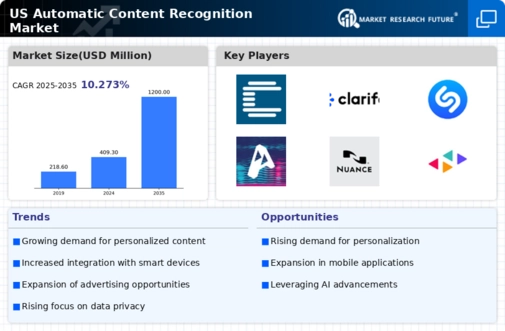Expansion of Digital Advertising
The automatic content-recognition market is significantly influenced by the expansion of digital advertising. As advertisers increasingly leverage digital platforms, the need for effective content recognition tools becomes paramount. These tools enable advertisers to analyze viewer engagement and optimize ad placements based on real-time data. In 2025, digital advertising spending in the US is expected to surpass $200 billion, with a substantial portion allocated to video and interactive content. Automatic content-recognition technology allows advertisers to track content performance and audience interactions, thereby enhancing the effectiveness of advertising campaigns. This driver underscores the importance of integrating automatic content-recognition solutions into advertising strategies to maximize return on investment and reach targeted audiences effectively.
Growth of User-Generated Content
The automatic content-recognition market is poised for growth due to the increasing prevalence of user-generated content (UGC) across various platforms. As social media and video-sharing sites flourish, the volume of UGC continues to rise, necessitating robust content recognition technologies. Businesses are leveraging automatic content-recognition solutions to monitor and analyze UGC, ensuring compliance with copyright regulations and enhancing content curation. In 2025, it is estimated that UGC will account for over 50% of all online content, highlighting the need for effective recognition tools. This driver illustrates how automatic content-recognition technology is essential for managing the complexities associated with UGC, enabling brands to harness its potential while mitigating risks.
Rising Demand for Content Personalization
The automatic content-recognition market experiences a notable surge in demand for personalized content experiences. As consumers increasingly seek tailored media, businesses are compelled to adopt advanced technologies that facilitate content recognition. This trend is particularly evident in sectors such as streaming services and social media platforms, where user engagement is paramount. According to recent estimates, the market is projected to grow at a CAGR of approximately 20% over the next five years, driven by the need for enhanced user experiences. Companies are investing in automatic content-recognition solutions to analyze user preferences and deliver customized content, thereby improving customer satisfaction and retention. This driver highlights the critical role of automatic content-recognition technology in shaping the future of media consumption and engagement.
Advancements in Machine Learning Algorithms
The automatic content-recognition market benefits from advancements in machine learning algorithms, which enhance the accuracy and efficiency of content recognition processes. As these algorithms evolve, they enable more sophisticated analysis of audio and visual content, leading to improved recognition capabilities. The integration of machine learning into automatic content-recognition solutions allows for real-time processing and analysis, which is crucial for industries such as broadcasting and live events. In 2025, the market for machine learning in content recognition is projected to reach $5 billion, reflecting the growing reliance on these technologies. This driver emphasizes the transformative impact of machine learning on the automatic content-recognition market, paving the way for innovative applications and improved user experiences.
Increased Regulatory Focus on Content Monitoring
The automatic content-recognition market is increasingly shaped by regulatory requirements surrounding content monitoring and compliance. As governments and regulatory bodies impose stricter guidelines on content usage, businesses are compelled to adopt automatic content-recognition technologies to ensure adherence. This trend is particularly relevant in sectors such as broadcasting and online media, where content rights and licensing are critical. In 2025, it is anticipated that compliance-related expenditures in the media industry will exceed $10 billion, driving demand for effective content recognition solutions. This driver highlights the necessity for businesses to integrate automatic content-recognition technologies to navigate the evolving regulatory landscape and mitigate potential legal risks.

















Leave a Comment